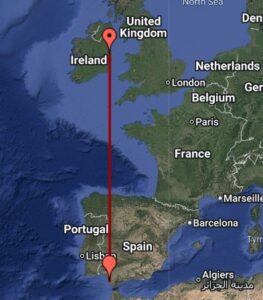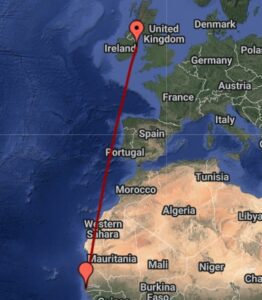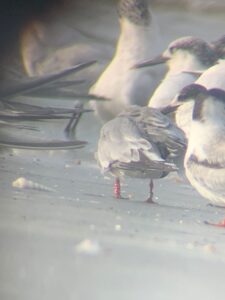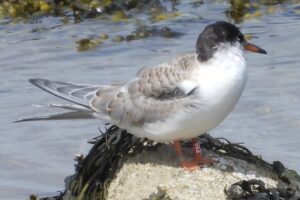The Dublin Bay Birds Project continues to build on long-term monitoring of one of Ireland’s most important breeding colonies of Terns, in Dublin Port.
As part of this work, we aim to ring every chick that hatches within the port. This work is essential to understanding the demography and migratory patterns of these remarkable seabirds — from their post-breeding movements and long-distance migrations to where and when they return to breed, whether back at Dublin Port or at other colonies across the Irish Sea and beyond. We have also put an increased focus on measuring adult survival rates, which we can combine with nesting numbers and breeding success to get a broader view of the population. With increased pressures facing the terns such as climate change, declines in fish stocks and offshore development, this level of insight is very important.
Remarkable resightings
Each year brings a few standout stories from the field, and this season has been no exception. During recent mist net trapping at Sandymount Strand (reported in our last update), we had a rare and exciting encounter: a tern that was first ringed in Senegal. Resightings like this are uncommon, but they reveal the extraordinary connectivity between Ireland and the west coast of Africa, shedding light on the vast journeys these birds undertake and the landscapes they rely on along the way.
(Map highlighting the distance travelled of a fledgling Common Tern, from Dublin Port to Cadíz, Spain.)
On 19th August this year, one of our fledgling Common Terns was spotted off the coast of Cadíz, Spain. This bird was colour ringed on 27th June and, at that time, would have been unable to fly. Yet, in a matter of weeks, this bird took its first flight, left its natal colony for the first time and began its southbound migration to Africa. Out of the thousands of tern chicks we’ve ringed, there have only been a handful of resightings in Spain and getting a better understanding of stopover sites and timing of these movements is very useful.
(Map highlighting the distance travelled of a fledgling Common Tern, from Dublin Port to Kartong Bird Observatory, The Gambia.)
Perhaps more impressively, on 14th October 2025, a juvenile Common Tern ringed in Dublin Port earlier this year was recorded at Kartong Bird Observatory in The Gambia — over 4,575 km away, as the ‘tern’ flies. This too is an important stopover site and the team at Kartong Bird Observatory put in a huge effort to ring-read every year, spotting birds like Common Terns, Sandwich Terns and Lesser Black-backed Gulls from Irish colonies as they head southwards for the winter.
(Fledgling Common Tern spotted at Kartong Bird Observatory, The Gambia. Photo: Oliver Fox)
Of course, while these resightings from distant countries are hugely exciting, we’re equally delighted to get ring reads from much closer to home. These resightings — whether they’re from Blackrock and Seapoint in Dublin, or North Wales, Lancaster, Spain, and The Gambia — help us map the critical stopover and wintering sites used by terns ringed in Dublin. Such data are invaluable in understanding migration routes, dispersal behaviour, and habitat use, and they highlight the shared international responsibility for protecting these migratory species.
(Fledgling Common Tern roosting near Seapoint, Dublin. Photo: Graham Prole)
(Map highlighting the post-breeding ringing resightings this year of birds that have been ringed in the Dublin Port colony. Understanding their migration patterns is essential for their conservation.)
From Fledglings to Veterans
First ringed as a chick in Dublin Port in 1999, this tern has now completed 25 years of migration between Dublin Port down to the West Coast of Africa, a round trip of nearly 15,000km every year. This extraordinary longevity offers rare insight into the life history of the species and underscores the importance of long-term monitoring and conservation efforts. Interestingly, the previous longevity records in Dublin Port were Common and Arctic Terns both caught in 2023 at the age of 23 years old. Those two, and this years bird, all nested on the ‘CDL’ structure in Dublin Port, which is the oldest tern nesting structure in the Port. Terns can be very faithful to a nesting site, so it might be that conservation efforts in Dublin Port have allowed them to return to the same spot for over 20 years, rearing generation after generation of these amber-listed species.
Why This Work Matters
Migratory birds like terns face challenges across their entire range, from breeding and feeding to wintering grounds thousands of kilometres away. Understanding their full annual cycle is essential for effective conservation — and that’s only possible through consistent long-term research like that carried out at Dublin Port.
Thanks to support from Dublin Port Company and the Dublin Bay Biosphere, we’re able to continue this vital work. Every resighting, every recovery, every data point helps us better understand and protect these extraordinary birds not just here in Dublin, but across their vast migratory range.
All birds were ringed and handled under appropriate NPWS and BTO licenses.
The Dublin Bay Birds Projects is funded by:








